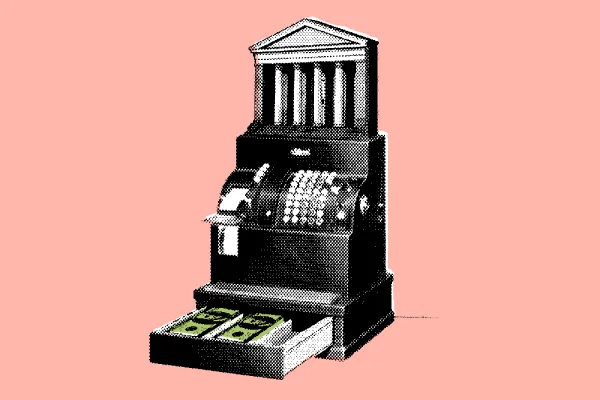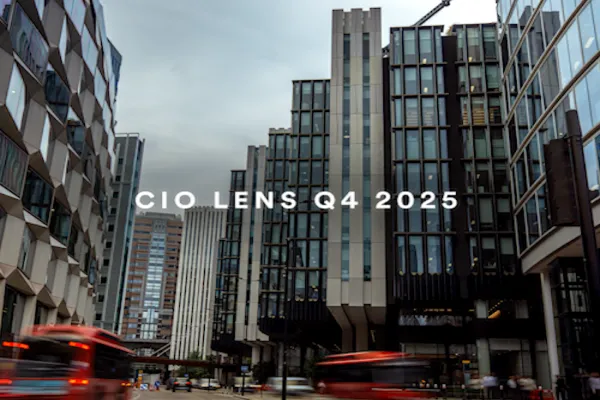“Gold is money. Everything else is credit.” — J.P. Morgan, 1912
As gold prices continue to shatter records, J.P. Morgan’s famously pithy remark about the precious metal might be rephrased for our era: Gold feels certain. Everything else feels uncertain.
In my conversations over the past year with corporate leaders, association executives, institutional investors, and entrepreneurs, a recurring theme has emerged: extreme uncertainty.
Amid this uncertainty, gold has skyrocketed. Since 2022, gold prices have nearly doubled, hitting a fresh record on Tuesday at more than $4000/ounce. In the search for safe havens amid volatility, central banks, institutional investors and others have flocked to gold.
The current gold price run is fueled by a rising sense of uncertainty about the future. But this is not your typical run-of-the-mill uncertainty, the kind that is an everyday feature of business, economies, politics, societies and even our personal lives. This time, the uncertainty feels deeper and more pervasive and cuts across institutions, currencies, and global orders that were assumed to be broadly stable.
There is a sense that the ground beneath our feet is shaking, and, in such an environment, investors instinctively gravitate toward the one asset that has endured every storm: gold.
Amid this storm, however, it’s worth asking: are we witnessing some heavy rain and passing thunder or a hurricane with gale force winds? Might today’s “extreme uncertainty” feel more extreme because of our extreme connectivity, and extreme social media usage?
In short, is all the fear of extreme uncertainty warranted?
Before we declare today’s turbulence uniquely perilous, it helps to take a step back. Uncertainty is not a modern invention, but a recurring condition of global life. Each era has had its own shifting goalposts, its own disorienting shocks, and its own vocabulary for grappling with change.
Back in the late 1980s, the U.S Army war College coined an acronym to explore the coming post-Cold war world: VUCA, for Volatility, Uncertainty, Complexity, and Ambiguity. It’s a concept that has stood the test of time, and is used regularly today in corporate strategy sessions, business schools, and planning scenarios.
The VUCA world seems particularly appropriate for our era of uncertainty today, fueled by a wide range of factors from shifting U.S tariff policies to geopolitical fractures to multiple wars to a slowing global economy – all in the shadow of the massively uncertain future of Artificial Intelligence.
For many, it seems we may have entered an extreme VUCA world? VUCA squared? VUCA+? You get the point.
But, hold on a minute. We have faced bouts of extreme uncertainty over the past century or so that have been either more extreme or on par with the past few years: two world wars, a Cold war with the possibility of nuclear annihilation, the fall of the Soviet Union, the 9/11 attacks and the wars in Iraq and Afghanistan, the 2008 global financial crisis, and, of course, the mother of all uncertainties: the Covid-19 pandemic that shut down the world.
In that context, uncertainty about what Vladimir Putin will do next in Ukraine, what President Trump will decide on tariffs, whether the Fed cuts rates by 50 basis points or 25, or how oil prices will shake out, might be seen as part of a larger continuum, rather than exceptional. (Indeed, on tariffs, President Trump clearly uses uncertainty as bargaining leverage. It’s a feature, not a bug.)
So, we might need to do something humans do not like to do: accept the unknowns and the unknowables, and move on to a ground that is more stable. We might all be better off going deeper, and exploring the structural trends shaping our world. How do those forces fare in our extreme VUCA world?
Let’s start with trade - a trend as old as the earliest civilizations. Of course, hyper-charged trade today is a lot different than the caravan routes of Sumerian traders or the grain exchanges along the Nile that sustained Egyptian merchants, but the underlying impulse is the same: people and societies seeking connection, exchange, and profit. It’s true that U.S. tariffs today are the highest they’ve been since the 1930s, but recall why the infamous Smoot-Hawley tariffs proved so destructive: they triggered a cascade of retaliatory measures that choked global commerce. So far, most countries have not retaliated in kind. Global trade continues to expand, albeit at a slower pace, and more nations are actively seeking ways to reduce their dependence on the outsized pull of U.S. demand.
As Ngozi Okonjo-Iweala, Director-General of the World Trade Organization, wrote in the Financial Times,“Despite all this, the rest of the world has mostly continued to trade on normal terms, as businesses scramble to recalibrate. WTO analysis suggests that roughly 72 per cent of global goods trade is still operating on basic ‘most favoured nation’ (MFN) tariff terms. This is down from 80 per cent at the beginning of the year, and may dip further. But the system is showing resilience. WTO members have, at least thus far, avoided what could have been a bruising retaliatory trade war with the US. And they have generally refrained from escalating restrictions on each other’s goods and services, as happened in the 1930s.”
Even the U.S-China trade relationship has weathered the storm. If the first seven months of 2025 trade figures hold up, the two countries are headed for total goods trade of roughly $440 billion. If we add in services, it will be north of $500 billion. To be sure, this is a fall from 2024’s goods and services tally of $658 billion, but it is not a collapse. What’s more, if President Trump gets his wish and he can reduce US deficits with China by selling more goods to the middle Kingdom, the trade numbers will balloon again.
Global trade today, however, is not only the story of major economies’ trade relationships. Supply chains are being rewired, new trade corridors are opening, and regional blocs are strengthening. Regions and countries are also exploring new ways to connect. Witness the EU-Mercosur trade deal in the works, or the UAE’s dizzying series of trade agreements with partners ranging from India to Colombia. Consider also the African Continental Free Trade Area (AfCFTA), which is knitting together 54 countries into the world’s largest new trading bloc, albeit one with major obstacles to surmount.
Then, there’s the Regional Comprehensive Economic Partnership (RCEP) that links much of Asia into a tariff-reducing network, while U.S. and European firms are increasingly diversifying supply chains into “China+1” strategies, adding Vietnam, Mexico, or Cambodia as critical nodes. Frankly, given the unpredictable nature of tariffs, it may be wiser to pursue a China+2 or +3 strategy - which implies more globalization, not less. And let’s not forget that the U.S still imports a large amount of goods from China, nearly $200 billion in the first seven months of 2025, even amid the tariff battles.
Still, as tariff fights dominate headlines, the structural trend of global connectivity remains intact. Container ships continue to move record tonnage, air cargo remains robust, and digital trade has exploded to become one of the fastest-growing segments of global commerce.
Why has trade remained so stubborn? Didn’t the pundits tell us that globalization was on the decline or dying?
The main reason is structural: the collapse of distance, time, and cost through technology over the past several decades. Container shipping, fiber optic cables, air cargo, and digital platforms have compressed the world in ways unimaginable just a generation or two ago. These connective technologies have not erased geography, but they have dramatically reduced its frictions.
At the same time, demographics present another deep current of stability. Populations in Europe and East Asia may be aging rapidly, but South Asia and Africa are bursting with young people. India adds the equivalent of a medium-sized European country to its workforce every year. Africa, with the world’s youngest population, is expected to double its labor force by 2050. And the world is increasingly urban - 55% by UN estimates, and headed for two-thirds by 2050. These trends won’t prevent short-term volatility. In fact, they may exacerbate it - young, urbanized, wired populations can be both a demographic gift and a demographic burden. Still, these trends will anchor the long-term trajectory of growth and consumption.
Connectivity is another structural force too often overlooked amid the noise of uncertainty. Fiber optic cables, undersea internet lines, and low-earth orbit satellites knit our world together more tightly each day. Ports from Jebel Ali to Singapore to Rotterdam are not shrinking in relevance. They are expanding to handle more trade, more goods, and more interlinked economies.
While ESG may be currently out of favor or downplayed, the energy transition continues. Today, some 40% of electricity is generated by clean power, more than double the number of two decades ago. That number will likely rise over the next decade.
BeyondESG, the world should be focused on EFM - Energy, Food and Metals. The countries and companies well-positioned in these sectors will thrive amid the structural trends driving our world.
In short, while the headlines scream uncertainty, the reality on the ground points to continuity. Trade continues. Demographics marches on. Connectivity deepens. Technology disrupts. These are not trivial forces. They are tectonic plates beneath the surface storms.
These are the stubborn facts of our age, and they help explain why, even as gold shines in moments of doubt, the world’s long-term currents point toward continued integration, albeit in different shapes, and steady growth.
Does this mean gold’s run is unwarranted? No. There’s still plenty to be uncertain about, including concerns about the institutions that have shaped our world from the U.S Federal Reserve to the global trading system. Our global operating system is being disrupted, dismantled, or upgraded, depending on your point of view - and the institutions that undergird that system are feeling wobbly.
“Gold is a store of value that doesn’t rely on institutional trust,” Daan Struyven, co-head of global commodities research at Goldman Sachs, was quoted as saying in the FT. Struyven points to possible damage to the independence of the Federal Reserve from the current stand-off between President Trump as a trigger point for higher gold prices.
A weakening of the Fed could spook investors away from dollar assets such as U.S Treasuries or even stocks. “If 1 percent of the privately owned US Treasury market were to flow to gold, the gold price would rise to nearly $5,000 per ounce,” Struyven notes.
So, gold still glints brightly in the fog of uncertainty, but look beyond that fog and you might see the contours of a still stubbornly globalized world with steady structural drivers from demographics to connectivity to trade to urbanization. Investors and policymakers alike would do well to keep both lenses in view: hedge against the storms, yes, but also recognize the tectonic shifts that make the global economy more resilient than the daily headlines suggest.
In that balance between fear of the present and faith in the long arc of continuity might be the real story of our times.
Afshin Molavi is a Senior Fellow at the Foreign Policy Institute of the Johns Hopkins University School of Advanced International Studies (SAIS).
The views expressed are solely those of the author in their personal capacity and do not constitute investment advice or an offer to buy or sell any financial instrument.
The views expressed by the author do not necessarily reflect the views of Institutional Investor.
Market Intelligence Is Independent of the Institutional Investor Magazine Newsroom.







